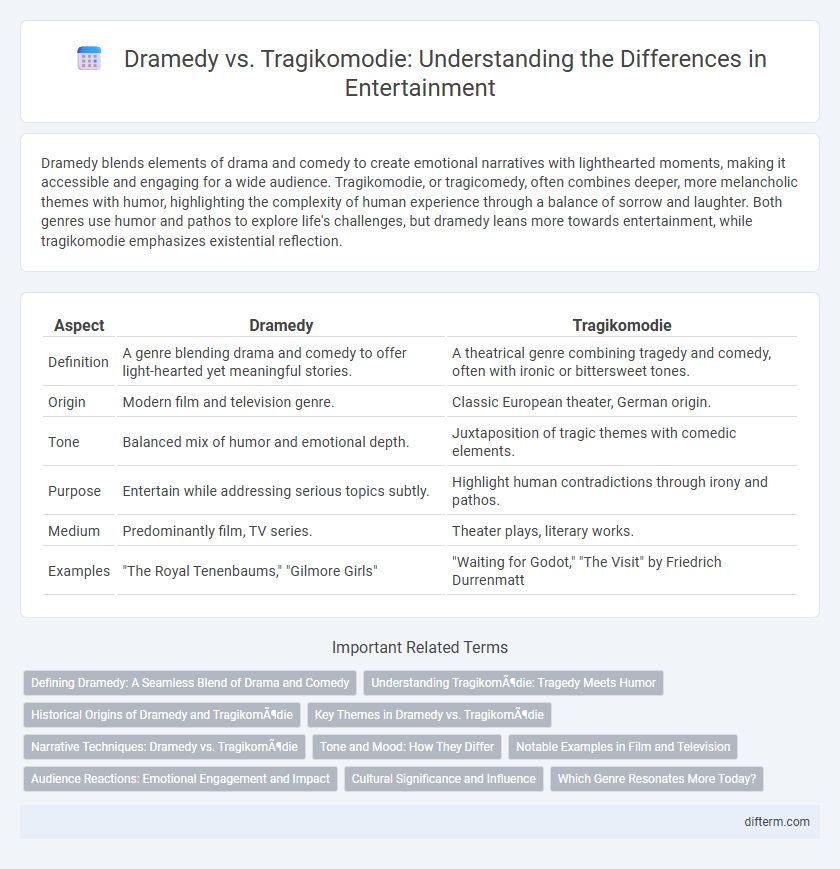Dramedy blends elements of drama and comedy to create emotional narratives with lighthearted moments, making it accessible and engaging for a wide audience. Tragikomodie, or tragicomedy, often combines deeper, more melancholic themes with humor, highlighting the complexity of human experience through a balance of sorrow and laughter. Both genres use humor and pathos to explore life's challenges, but dramedy leans more towards entertainment, while tragikomodie emphasizes existential reflection.
Table of Comparison
| Aspect | Dramedy | Tragikomodie |
|---|---|---|
| Definition | A genre blending drama and comedy to offer light-hearted yet meaningful stories. | A theatrical genre combining tragedy and comedy, often with ironic or bittersweet tones. |
| Origin | Modern film and television genre. | Classic European theater, German origin. |
| Tone | Balanced mix of humor and emotional depth. | Juxtaposition of tragic themes with comedic elements. |
| Purpose | Entertain while addressing serious topics subtly. | Highlight human contradictions through irony and pathos. |
| Medium | Predominantly film, TV series. | Theater plays, literary works. |
| Examples | "The Royal Tenenbaums," "Gilmore Girls" | "Waiting for Godot," "The Visit" by Friedrich Durrenmatt |
Defining Dramedy: A Seamless Blend of Drama and Comedy
Dramedy expertly fuses dramatic storytelling with comedic elements to create a balanced narrative that evokes both laughter and emotional depth. This genre combines character-driven plots that explore serious themes while incorporating humor to lighten the atmosphere. Dramedy differs from Tragikomodie by maintaining a more accessible tone, embracing both emotional complexity and entertainment without leaning heavily into tragedy.
Understanding Tragikomödie: Tragedy Meets Humor
Tragikomodie blends the emotional depth of tragedy with the lightness of humor, creating a unique narrative that reflects life's complexities. Unlike traditional dramedy, which balances drama and comedy separately, Tragikomodie integrates both elements within the same scenes, enhancing the audience's emotional engagement. This fusion allows for a nuanced exploration of human experiences, where humor serves to soften the impact of tragic events without diminishing their significance.
Historical Origins of Dramedy and Tragikomödie
The historical origins of dramedy trace back to early 20th-century American theater where playwrights blended dramatic and comedic elements to reflect complex human experiences. Tragikomodie, rooted in German literature and theater from the Renaissance period, traditionally combined tragic and comic motifs to explore themes of existential contradiction and human folly. Both genres evolved by challenging conventional boundaries, with dramedy emphasizing emotional realism and tragikomodie highlighting philosophical depth.
Key Themes in Dramedy vs. Tragikomödie
Dramedy blends comedic and dramatic elements to explore everyday struggles with humor and emotional depth, often highlighting personal growth, relationships, and resilience. Tragikomodie, or tragicomedy, navigates the coexistence of tragedy and comedy by emphasizing existential dilemmas, human suffering, and absurdity within a somber narrative framework. The key themes in dramedy center around balance and relatability, whereas tragicomedy delves into the paradoxes of life and the fusion of sorrow with levity.
Narrative Techniques: Dramedy vs. Tragikomödie
Dramedy blends comedic and dramatic elements using character-driven storytelling and relatable dialogue to balance humor and emotional depth. Tragikomodie employs irony and juxtaposition, integrating tragic themes with dark humor to evoke complex emotional responses. Both genres utilize narrative ambiguity but differ in tone, with dramedy leaning toward optimism and tragikomodie emphasizing existential tension.
Tone and Mood: How They Differ
Dramedy blends comedic elements with dramatic storytelling, maintaining a lighthearted tone that balances humor and emotional depth, creating a mood that is both uplifting and thought-provoking. Tragikomodie, or tragicomedy, emphasizes a more somber tone by integrating serious, tragic themes with moments of irony or dark humor, resulting in a mood that is complex and reflective, often evoking sadness intertwined with subtle levity. The key difference lies in dramedy's predominantly optimistic atmosphere versus tragikomodie's nuanced interplay of sorrow and humor.
Notable Examples in Film and Television
Notable examples of dramedy in film and television include "The Marvelous Mrs. Maisel" and "Orange is the New Black," where humor intertwines with dramatic narratives to evoke a wide range of emotions. In contrast, tragikomodie is exemplified by works like "Life is Beautiful" and "Fargo," blending tragedy and comedy to highlight the absurdity and poignancy of human experience. These genres utilize tonal shifts to create complex storytelling that resonates deeply with audiences.
Audience Reactions: Emotional Engagement and Impact
Dramedy blends drama and comedy to evoke laughter and heartfelt emotions, fostering a balanced audience reaction that ranges from amusement to profound reflection. Tragikomodie emphasizes tragic themes softened by ironic or comedic elements, intensifying emotional engagement through a complex interplay of sorrow and dark humor. Audience impact in both genres hinges on the nuanced storytelling that challenges viewers to navigate conflicting emotions, resulting in a memorable and thought-provoking entertainment experience.
Cultural Significance and Influence
Dramedy blends dramatic and comedic elements to reflect contemporary social realities, resonating strongly with global audiences and influencing modern television and film narratives. Tragikomodie, rooted in European theatrical tradition, merges tragedy and comedy to explore existential themes and emotional complexity, often impacting literary and stage arts. Both genres shape cultural storytelling by challenging audience perceptions and expanding emotional engagement through their unique hybrid forms.
Which Genre Resonates More Today?
Dramedy combines comedic and dramatic elements to create relatable narratives that reflect everyday experiences, appealing broadly due to its balance of humor and emotional depth. Tragikomodie, or tragicomedy, traditionally blends tragedy with comedy, often emphasizing existential themes and darker humor that resonate more within niche audiences. In today's entertainment landscape, dramedy resonates more widely as viewers seek comfort and reflection in stories that navigate real-life complexities with a lighter, more accessible tone.
Dramedy vs Tragikomödie Infographic

 difterm.com
difterm.com